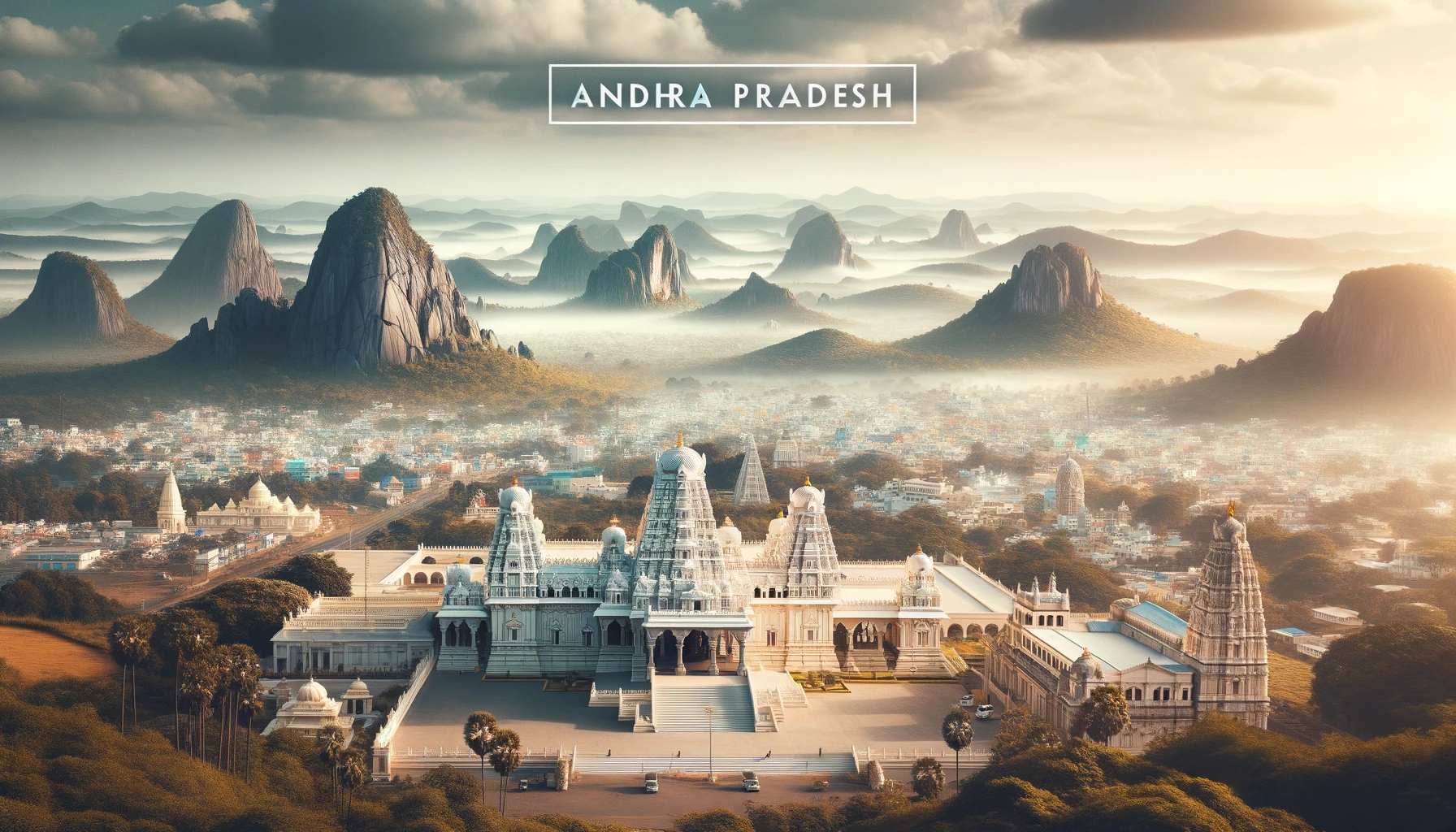Introduction to Andhra Pradesh
Andhra Pradesh, often referred to as the “Rice Bowl of India,” is a vibrant state located in the southeastern part of the country. With its rich traditions, diverse landscapes, and historical significance, it holds a special place in the heart of India.

Geographical Overview
Andhra Pradesh is nestled in South India. It shares its borders with several states: Telangana to the northwest, Chhattisgarh to the north, Odisha to the northeast, and Tamil Nadu to the south. To the east, it has a vast coastline along the Bay of Bengal.
Quick Facts about Andhra Pradesh
|
Fact |
Detail |
|
Location |
South India |
|
Capital |
Amaravati |
|
Largest City |
Visakhapatnam |
|
Official Language |
Telugu |
|
State Bird |
Rose-ringed parakeet |
|
State Animal |
Blackbuck |
Historical Significance
The history of Andhra Pradesh is as vast as its landscapes. It’s a tapestry woven with tales of ancient dynasties, brave rulers, and significant events that shaped its present.
Ancient Times: The Beginnings
The earliest references to the Andhras can be found in the Aitareya Brahmana, a sacred Hindu text. It suggests that people from North India migrated to this region around 800 BCE.
Mauryan Empire (4th Century BC)
The Mauryan Empire, one of India’s largest empires, extended its rule over Andhra Pradesh. King Ashoka, a notable Mauryan ruler, brought Buddhism to the region.
Satavahana Dynasty (1st Century BC to 3rd Century AD)
|
Key Figures |
Contributions |
|
Gautamiputra Satakarni |
Expanded the empire, patron of Brahmanism |
|
Hala |
Wrote “Gathasaptashati”, a collection of poems |
The Satavahanas, also known as the Andhras, were the first great dynasty to rule over Andhra Pradesh. They promoted trade, art, and culture. The region flourished under their rule, with Amaravati becoming a significant Buddhist center.
Pallavas and Eastern Chalukyas (4th to 9th Century)
The Pallavas and Eastern Chalukyas were two influential dynasties that left their mark on Andhra Pradesh. They constructed many temples and promoted local arts.
Kakatiyas (12th to 14th Century)
Warangal, the capital of the Kakatiya dynasty, saw significant development during this period. The Kakatiyas built the famous Warangal Fort and promoted Telugu literature.
Vijayanagara Empire (14th to 17th Century)
The Vijayanagara Empire, known for its grandeur and cultural contributions, also ruled over Andhra Pradesh. They built the famous Hampi ruins, which are now a UNESCO World Heritage site.
British Raj (18th to 20th Century)
The British East India Company started its rule in Andhra Pradesh in the 18th century. The region witnessed many revolts and movements against British rule, with leaders like Alluri Sitarama Raju leading the charge.
In 2014, a significant event took place. Andhra Pradesh was bifurcated, leading to the formation of a new state, Telangana. However, Andhra Pradesh retained its cultural and historical identity, continuing to be a vital part of India’s story.
This detailed overview provides a comprehensive understanding of Andhra Pradesh’s position, significance, and history. The state’s journey, from ancient times to the present, reflects its resilience, cultural richness, and the indomitable spirit of its people.
Geography of Andhra Pradesh
Andhra Pradesh boasts a diverse landscape, from the lush green coastal plains to the rugged terrains of the Eastern Ghats. This state has the second-longest coastline in India, stretching over 970 kilometers along the Bay of Bengal.
Key Geographical Features
|
Feature |
Description |
|
Eastern Ghats |
A range of mountains running through the state |
|
Coastal Plains |
Fertile lands ideal for agriculture |
|
Krishna & Godavari |
Major rivers providing water resources |
|
Coromandel Coast |
The coastal region along the Bay of Bengal |
Economy and Natural Resources
Andhra Pradesh’s economy is a mix of agriculture, industry, and services. The fertile lands, especially in the delta regions of the Krishna and Godavari rivers, make it a significant agricultural state.
Major Economic Contributors
|
Sector |
Key Products/Services |
|
Agriculture |
Rice, sugarcane, cotton, and tobacco |
|
Fisheries |
Shrimp and fish production |
|
Industries |
Pharmaceuticals, textiles, and IT |
|
Natural Resources |
Limestone, baryte, oil, and natural gas |
The state is also a major producer of minerals. It’s rich in limestone, which is essential for the cement industry. The Krishna-Godavari basin holds vast reserves of oil and natural gas, making it a hub for petrochemical industries.
Culture and Tourism
Andhra Pradesh is a melting pot of cultures. Its traditions, art forms, and festivals are a reflection of its rich heritage.
Cultural Highlights
|
Element |
Details |
|
Dance |
Kuchipudi, a classical dance form |
|
Crafts |
Kondapalli toys and Dharmavaram saris |
|
Festivals |
Ugadi (New Year) and Sankranti |
|
Cuisine |
Spicy foods like pulihora (tamarind rice) and pootharekulu (sweet) |
Tourism in Andhra Pradesh
The state is a traveler’s delight, offering a mix of historical sites, natural wonders, and religious destinations.
|
Place |
Attraction |
|
Tirupati |
Venkateswara Temple, a major pilgrimage site |
|
Visakhapatnam |
Beaches and the submarine museum |
|
Amaravati |
Ancient Buddhist stupas |
|
Araku Valley |
Hill station with coffee plantations |
Conclusion
Andhra Pradesh, with its diverse landscapes, rich history, and vibrant culture, stands as a testament to India’s multifaceted heritage. Whether you’re a history buff, a nature lover, or someone seeking spiritual solace, this state has something to offer for everyone.
From the rhythmic beats of the Kuchipudi dance to the aromatic flavors of its cuisine, every aspect of Andhra Pradesh invites you to delve deeper and explore its many wonders. It’s not just a state; it’s an experience waiting to be unraveled.